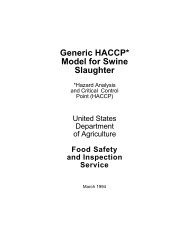Generic HACCP Model for Thermally Processed Commercial
Generic HACCP Model for Thermally Processed Commercial
Generic HACCP Model for Thermally Processed Commercial
Create successful ePaper yourself
Turn your PDF publications into a flip-book with our unique Google optimized e-Paper software.
Clostridium botulinum type A was cultured from his stool. The three persons had shared<br />
two canned foods: home-canned green beans and commercially canned beef stew. The<br />
green beans were initially assumed to be the cause of the outbreak. However, the empty<br />
stew can was recovered from the garbage, and washings from the can yielded C<br />
botulinum, type A, and its toxin.<br />
Gilbert, R. J., J. L. Kolvin, and D. Roberts. 1982. Canned foods - the problems of food poisoning<br />
and spoilage. Health and Hygiene 4(2/3/4):41-47.<br />
Canned foods are incriminated in only a small proportion of recorded outbreaks of food<br />
poisoning and food-borne diseases in the UK. Outbreaks reported from freshly opened<br />
canned food from 1929 to 1980, and the products incriminated are summarized in tables.<br />
Special mention is made of botulism associated with canned salmon in 1978, and<br />
staphylococcal food poisoning from corned beef in 1979. Causes of microbial<br />
decomposition and origins of spoilage are briefly discussed, and 4 examples are<br />
considered in more detail in tables: swollen cans of chopped pork from Poland (due to<br />
underprocessing); blown cans of pork shoulder from the Netherlands (due to incorrect<br />
storage); safety of canned corned beef from Brazil (water damage from barge sinking in<br />
R. Thames); and bottled complete milk <strong>for</strong>mula <strong>for</strong> babies (underprocessing resulted in<br />
Bacillus coagulans counts of 4.5 x 10-6ml). A scheme of microbiological examination <strong>for</strong><br />
canned meat is given which could be applied to other foods.<br />
Guilfoyle, D. E. and J. F. Yager. 1983. Survey of infant foods <strong>for</strong> Clostridium botulinum spores.<br />
J. Association Official Analytical Chemists 66(5):1302-1304.<br />
A total of 236 samples of infant foods, including honey, dry cereal, dried skim milk,<br />
evaporated milk, canned <strong>for</strong>mula, and canned baby food, were collected in the New York<br />
City area and tested <strong>for</strong> the presence of C. botulinum spores. Methods <strong>for</strong> recovery of<br />
spores were validated using foods spiked with 4 spores/ml or g. None of the products<br />
contained C. botulinum spores, indicating that their incidence in these commercial foods<br />
is not widespread. This limited study did not identify any food types that could be<br />
suspected of being involved in the transmission of infant botulism.<br />
Odlaug, T. E. and I. J. Pflug. 1978. Clostridium botulinum and acid foods. J Food Prot.<br />
41(7):566-573.<br />
The problem of botulism in canned acid foods is reviewed, analyzed and discussed. In the<br />
period 1899-1975, 722 outbreaks of botulism were reported in the USA; 4.7% were due<br />
to home-processed acid foods and 0.1% to commercially-processed acid foods (the<br />
remainder being due to home- and commercially-processed low acid foods).<br />
Contamination of food with C. botulinum, effect of pH on C. botulinum and survival of<br />
spores in acid foods are considered, as are types of process failures during canning, and<br />
conditions necessary <strong>for</strong> C. botulinum growth in an acid food with a process failure.<br />
Presence of other viable microorganisms may cause the pH of an apparently safe food to<br />
64



